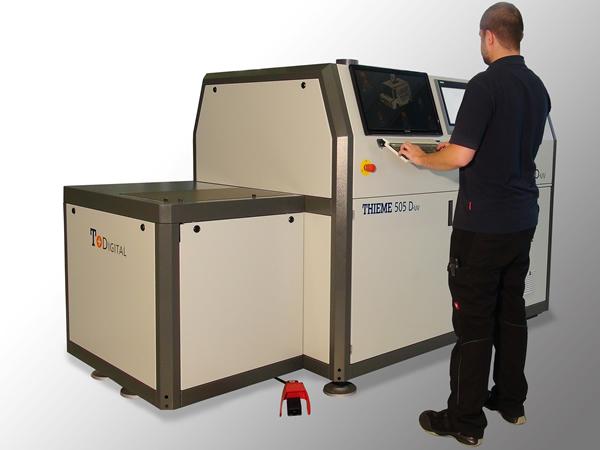
Date: 9 November 2017
The innovative HydroGel technology developed in cooperation with printing ink manufacturer TRITRON combines high printing quality with low printing costs.
To date, films that were deep-drawn or back-sprayed after printing could only be screen-printed. However, this only permits limited reproduction of color graduations or fine scripts, and considerable equipment effort occurs on smaller piece numbers.
Based on the Thieme digital printing platform, the first digital printing solution specifically for such applications is available now. This not only expands the graphical options, but also permits cost-efficient small series production.
The innovative printing system makes it possible for the first time to use the new Hydro¬Gel procedure of printing ink manufacturer Tritron. In contrast to common digital printing, where the printing ink is fixated with UV light, HydroGel uses water-based inks that are fixated drop by drop with a special liquid previously applied precisely in the inkjet procedure.
"The ink drop gels when it hits the pretreatment," Tritron's managing director Dr. Jens Simon describes the sophisticated procedure. "This reliably prevents bleeding, i.e. spreading of the ink drops on the non-absorbent film base."
A matching overall solution of ink and technology
"Only perfect interaction between Tritron ink and Thieme machine technology permitted implementation of this innovative printing procedure," adds Harry Götz, product manager for digital printing at Thieme.
"For the first time, a matching overall solution is available for printing subsequently deep-drawn and back-sprayed films." Equipped with 7-pl-printing heads, the machine permits a very fine resolution at an undiminished printing speed as compared to the usual UV process. The ink can be processed stably and adheres very well.
For the HydroGel process, the Thieme digital printing machines are equipped with special additional functions. This includes an automatic sealing (capping) of the printing heads that prevents drying in of the water-based printing inks, automatic printing head cleaning, extraction and exprotection measures for safe processing of the alcohol-based fixating liquid.
Apart from this special equipment, users can use all common machine options that are already available for the UV machine versions. Harry Götz particularly recommends the vacuum table with application pins to users: "It makes precise alignment of screen to digital print easier in particular in flexible materials such as films."

Flexible forming after printing
Typical applications of the new digital printing method include film prints for buttons and operating covers in automotive use, on household and medical-technology devices. A film is first printed on flat on the rear and then shaped as desired by thermal forming (deep-drawing). Finally, the film is back-sprayed with plastic.
"The HydroGel print is temperature-resistant, so that even higher temperatures are no problem in these process steps," promises Dr. Jens Simon from Tritron. This way, the technology can also be used in other applications, such as chip card production, where lamination processes are performed subject to high temperatures.
 Since a digital printing machine of the THIEME 3020 D series with HydroGel-technology has already been successfully used, Thieme has adapted the innovative procedure for smaller printing formats. This was taken as an opportunity to revise the existing THIEME 500 D completely and to optimize it in terms of space demand and operating concept.
Since a digital printing machine of the THIEME 3020 D series with HydroGel-technology has already been successfully used, Thieme has adapted the innovative procedure for smaller printing formats. This was taken as an opportunity to revise the existing THIEME 500 D completely and to optimize it in terms of space demand and operating concept.
The versions THIEME 505 D (max. printing format 400 x 600 mm) and 510 D (630 x 730 mm) are available now, both optionally with UV or HydroGel equipment. One of the new printing systems will be shown for the first time at the Thieme stand at InPrint (Hall A6 Booth 526).
 600450
600450




















Add new comment